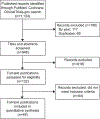Intrauterine Device Expulsion After Postpartum Placement: A Systematic Review and Meta-analysis
- PMID: 30204688
- PMCID: PMC6549490
- DOI: 10.1097/AOG.0000000000002822
Intrauterine Device Expulsion After Postpartum Placement: A Systematic Review and Meta-analysis
Abstract
Objective: To estimate expulsion rates among women with postpartum intrauterine device (IUD) placement by timing of insertion, IUD type, and delivery method.
Data sources: We searched PubMed, Cochrane Library, and ClinicalTrials.gov from 1974 to May 2018.
Methods of study selection: We searched databases for any published studies that examined postpartum placement of a copper IUD or levonorgestrel intrauterine system and reported counts of expulsions. We assessed study quality using the U.S. Preventive Services Task Force evidence grading system. We calculated pooled absolute rates of IUD expulsion and estimated adjusted relative risks (RRs) for timing of postpartum placement, delivery method, and IUD type using log-binomial multivariable regression model.
Tabulation, integration, and results: We identified 48 level I to II-3 studies of poor to good quality. Pooled rates of expulsion varied by timing of IUD placement, ranging from 1.9% with interval placements (4 weeks postpartum or greater), 10.0% for immediate placements (10 minutes or less after placental delivery), and 29.7% for early placements (greater than 10 minutes to less than 4 weeks postpartum). Immediate and early postpartum placements were associated with increased risk of expulsion compared with interval placement (adjusted RR 7.63, 95% CI 4.31-13.51; adjusted RR 6.17, 95% CI 3.19-11.93, respectively). Postpartum placement less than 4 weeks after vaginal delivery was associated with an increased risk of expulsion compared with cesarean delivery (adjusted RR 5.19, 95% CI 3.85-6.99). Analysis of expulsion rates at less than 4 weeks postpartum also indicated that the levonorgestrel intrauterine system was associated with a higher risk of expulsion (adjusted RR 1.91, 95% CI 1.50-2.43) compared with CuT380A.
Conclusion: Postpartum IUD expulsion rates vary by timing of placement, delivery method, and IUD type. These results can aid in counseling women to make an informed choice about when to initiate their IUD and to help institutions implement postpartum contraception programs.
Conflict of interest statement
Financial Disclosure
The authors did not report any potential conflicts of interest.
Figures
Comment in
-
Intrauterine Device Expulsion After Postpartum Placement: A Systematic Review and Meta-Analysis.Obstet Gynecol. 2019 Mar;133(3):582. doi: 10.1097/AOG.0000000000003144. Obstet Gynecol. 2019. PMID: 30801456 No abstract available.
-
In Reply.Obstet Gynecol. 2019 Mar;133(3):582-583. doi: 10.1097/AOG.0000000000003145. Obstet Gynecol. 2019. PMID: 30801457 Free PMC article. No abstract available.
References
-
- Whitaker AK, Chen BA. Society of Family Planning Guidelines: postplacental insertion of intrauterine devices. Contraception 2018;97:2–13. - PubMed
-
- Kapp N, Curtis KM. Intrauterine device insertion during the postpartum period: a systematic review. Contraception 2009; 80:327–36. - PubMed
-
- Sonalkar S, Kapp N. Intrauterine device insertion in the post-partum period: a systematic review. Eur J Contracept Reprod Health Care 2015;20:4–18. - PubMed
-
- Curtis KM, Tepper NK, Jatlaoui TC, Berry-Bibee E, Horton LG, Zapata LB, et al. U.S. medical eligibility criteria for contraceptive use. MMWR Recomm Rep 2016;65:1–103. - PubMed
Publication types
MeSH terms
Grants and funding
LinkOut - more resources
Full Text Sources
Other Literature Sources
Medical
Research Materials


